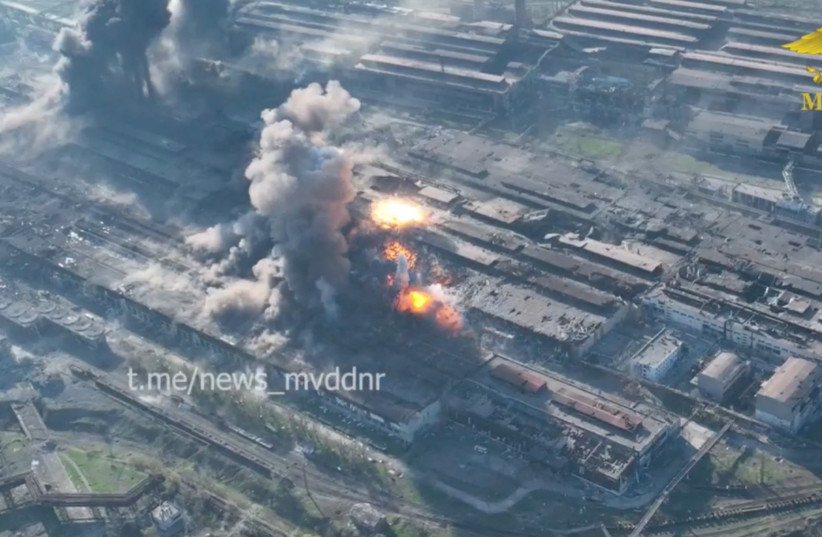Civilians still trapped in Mariupol
Scores of civilians, many of them women and children, remained trapped on Thursday in underground bunkers at a steelworks, the last Ukrainian holdout in the devastated city of Mariupol, but Russia promised a new lull in fighting to allow them to leave.
Ukraine's dogged resistance at the vast Azovstal plant has underscored Russia's failure to capture major cities during a 10-week war that has united Western powers in arming Kyiv and punishing Moscow with sanctions.
Slow Russian advance
Russia is orienting military forces around Lyman, southeast of Izyum, and have started to move north from Mariupol, but in general, there has been little change in the dynamics of the war, a senior US defense official said in a briefing on Thursday.
The Pentagon said that the Russian advance in Donbas and south Ukraine had been slower than the Kremlin anticipated. Part of the reason for the slow pace of military progress has been logistics and supply problems, which have plagued Russia's military since the beginning of the conflict.

"It varies from place to place, but in general, we don't believe they have solved their logistics and sustainment issues," said Pentagon Press Secretary John F. Kirby, adding that, "because they don't have it solved, they are warier about getting too far out ahead of their supply lines." He later said that Russia was suffering from leadership, unit cohesion and morale issues.
Ukrainian troops will be transitioning to counter-offensive operations in these areas, the commander-in-chief of the Armed Forces, Valery Zaluzhny, said.
Kirby also praised the Ukrainian resistance, which he said was not insignificant. He explained that Ukraine's familiarity with the region provides it with an advantage.
"They have absolutely impeded Russian progress in terms of their ability to take certain towns and villages – or even in the case when they have [taken them], they'd pull back and the Ukrainians re-take it," said Kirby.
There were indications that unfavorable weather conditions have slowed down movement, he said.
Russia is attempting to strike critical infrastructure in west Ukraine, such as electrical grids and transportation hubs, Kirby said in a press briefing on Thursday.
A senior US defense official said on Thursday that railroads in particular were being targeted. Ukrainian weapon production facilities were also being hit.
Kirby said that they were still uncertain how accurate the strikes had been and if they had been successful in damaging Ukrainian utilities.
"I would just remind [everyone] that their ability to target with precision has been less than advertised throughout this entire war," said Kirby. "They are not good at precision strikes. They are not discriminate with how they target."
The objective of the strikes may be to disrupt the transfer of western arms to Ukraine, said the officials.
"We think this is an effort to try to disrupt the Ukrainians' ability to replenish and reinforce themselves," said Kirby, adding that the pace of war material flow to Ukraine was continuing at a fast pace. A senior defense official said there was no impact by Russian strikes on the transfer of arms.
"The United States and NATO allies continue to flood Ukraine with weapons," Russian Defense Minister Sergei Shoigu said on Wednesday, Russian state media outlet TASS reported. "I would like to point out that we view all NATO vehicles that arrive in the country carrying weapons and supplies for the Ukrainian Armed Forces as legitimate military targets."
<br>Rumblings in neighboring countries
In Belarus, training exercises by local forces are likely being exaggerated by Russia to make Ukraine station forces in the north of the country, the UK Defense Ministry assessed in a Thursday morning intelligence update. It didn't believe that these exercises in Belarus actually posed a threat. The Pentagon also said it has seen no indication that Belarus intends to join the hostilities.
Ukraine is similarly wary of tensions in the separatist Transnistria region in Moldova, which according to the Ukrainian military is being provoked by Russia, it said Thursday morning. Moldova has said that it sees no imminent threat of unrest despite "provocations" by pro-Russian separatists, but has been making contingency plans for "pessimistic" scenarios, President Maia Sandu said on Wednesday.
War casualties
Since the beginning of the war, Russia says that it has destroyed 146 Ukrainian warplanes, 112 helicopters, 712 drones, 287 air defense systems, 2,817 Ukrainian tanks and armored vehicles, 323 multiple launch rocket systems (MLRS), 1,292 artillery pieces and 2,624 other ground vehicles.
Ukraine claims that Russia has lost almost 24,700 personnel in the war, although western intelligence estimates are often lower. Additionally, since January 24, Ukraine claimed to have destroyed 1,092 tanks, 2,651 armored fighting vehicles, 499 artillery pieces, 169 MLRS, 83 air defense systems, 196 warplanes, 155 helicopters, 10 ships and 312 drones.
Open-source intelligence analysts, keeping track of casualties with visual verification, often put the losses lower than both Ukrainian and Russian estimates.
Reuters contributed to this report.
